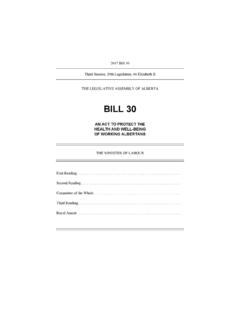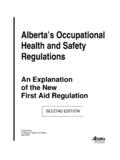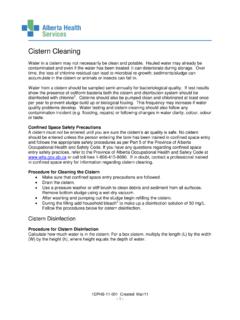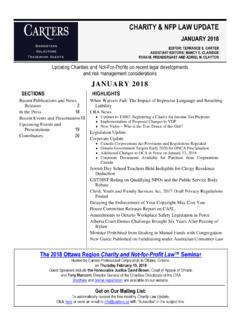Transcription of Pharmaceutical Manufacturing- Health Safety 2
1 1 Pharmaceuticals manufacturing : What do we know about the occupational Health and Safety hazards for women working in the industry?1 Dorothy Wigmore for Women and Health Protection March, 2009 1 This is an abridged version of occupational Health and Safety hazards in pharmaceuticals manufacturing : Past, present and future knowledge, policies and possibilities, particularly for women, written by Dorothy Wigmore for Women and Health Protection. 2 Table of Contents Table of Contents .. 2 1. Introduction .. 3 2. The Pharmaceutical industry .. 3 The labour force .. 3 The processes .. 5 Gender questions .. 8 3. Hazards .. 8 Introduction.
2 8 Pharmaceutical industry studies and reports .. 10 Chemical and mineral hazards and their effects .. 12 Biological and communicable hazards and their effects .. 18 Reproductive and genotoxic hazards and their effects .. 18 Carcinogens and their effects .. 20 Safety and mechanical hazards .. 21 Ergonomic design hazards and stressors .. 21 Summary .. 23 4. Approaches to preventing and reducing exposure to hazards .. 23 Risk assessment and the precautionary principle .. 23 occupational exposure limits (OELs) .. 25 Health and Safety laws .. 29 Canada - general .. 29 Laws and regulations relevant to Pharmaceutical R&D and manufacturing .. 30 Laws and regulations requiring use of the precautionary principle, substitution, toxics use reduction and other primary prevention methods.
3 31 Laws and regulations or particular relevance for women .. 32 United States .. 34 European Union .. 34 Environmental laws .. 36 5. Rules, guidelines and best practices in the Pharmaceutical industry .. 38 Canadian best practices examples .. 38 Pharmaceutical company approaches and best practices .. 38 Industry associations .. 40 6. Sex and gender considerations .. 42 7. Conclusions .. 43 8. Recommendations .. 44 Suggested further reading .. 46 Appendix 1 .. 47 References .. 50 3 1. Introduction Little is known about the Health risks of working in the Pharmaceutical industry. On the surface, the industry looks clean. The production of medicinals demands a carefully maintained and sterile working environment and the white lab coats worn by workers add to the illusion (Turshen, 1978).
4 The Pharmaceutical industry has been described as dynamic and growing, in terms of sales, number of employees, and GDP ( Health Canada, 2006; LeClerc, 2002). The Canadian government considers biopharmaceuticals to be an important innovation leader (Industry Canada, 2008b). It is an industry in which companies, government regulators and researchers focus on the Safety of the products and their effects on end users and the environment ( gerstrand, Rud n & Wester, 2008; Batt, 2004; Canadian Environmental Law Association & Lowell Center for Sustainable Production, 2009). However, the continuum of exposures to Pharmaceutical ingredients from development and manufacturing , through marketing and consumption, to our waterways also includes the workplace. Unfortunately, this key aspect of the life cycle of products in this sector is a poor cousin to other issues.
5 occupational Health and Safety (OHS) falls under the broad umbrella of public Health (Levy & Wegman, 2000). In 1950, the World Health Organisation (WHO) and the International Labour Organisation (ILO) declared that the goals of occupational Health should be to: promote and maintain the highest degree of physical, mental and social well-being of workers, prevent ill- Health among workers caused by their working conditions, protect workers from factors adverse to their Health in their employment, and place and maintain workers in occupational environments adapted to their individual physiological and psychological conditions. While more is known now than when Turshen wrote the statement quoted above in 1978, there still is much to learn about OHS hazards in the Pharmaceutical sector.
6 Gender-related issues are particularly important, since women comprise more than half of the Pharmaceutical research, development, and production workforce in Canada. Women have different biological responses to some hazards, are different from men in their shapes and sizes (whatever their heritage) and typically are exposed to different hazards than male co-workers. This paper describes how pharmaceuticals are developed and produced, and what is known about the associated hazards. It includes an overview of Health and Safety laws in Canada and elsewhere, as well as some examples of relevant best practices. We conclude with a series of recommendations. 2. The Pharmaceutical industry The labour force The Pharmaceutical manufacturing industry produces therapeutic substance human and veterinary medicines, drugs, and related products in an increasingly concentrated set of mostly transnational conglomerates and sub-contracting facilities.
7 The sector has five broad areas of 4 activity: research and development (R&D), manufacturing , sales and marketing, distribution, and administration. In Canada, about 24,000 people worked in the Pharmaceutical industry in 2001, up 22 percent in five years (Leclerc, 2002).2 By 2006, the census counted 29,715 people employed in the sector 15,880 women and 13,835 men. The jobs are concentrated in Quebec and Ontario, with small enclaves in British Columbia, Manitoba, and Nova Scotia (Statistics Canada, 2008). In the 1996 census, the major Pharmaceutical industry occupations were: technical sales specialists, wholesale trade (12%); chemists (6%); chemical plant machine operators (5%); and applied chemical technologists and technicians (5%). Women made up 73 percent of the business, finance and administrative occupations and 56 percent of occupations unique to processing, manufacturing and utilities (Human Resources and Skills Development Canada, 2007).
8 Data from 1999 indicated that sector employees worked an average of 39 hours weekly (two hours above the norm), had weekly overtime hours compared to for all industries, and were almost all full-time (part-time workers were 5 percent versus 19 percent for the whole economy) (HRSDC, 2007). Only 10 percent of the workforce was unionised in 1999, compared to a national rate of 31 percent (HRSDC, 2007). In the , only five percent of the drug manufacturing workforce is unionised. This is less than half the rate in other manufacturing jobs ( Bureau of Labor Statistics, 2007). In 2006, average wages in drug manufacturing facilities were $47,473 for production employees and $72,165 for administrative employees (Industry Canada, 2008b). Table 1 shows that in 2008, most establishments in Canada (usually individual workplaces) were in the micro, small or medium categories for number of employees (Statistics Canada, 2008 as cited in Industry Canada, 2008a).
9 Multinationals dominate the general market while smaller firms usually work in a specialized niche (Leclerc, 2002). Female-male breakdown is not 2 The actual numbers employed by Pharmaceutical companies are difficult to determine. R&D employees working outside a Pharmaceutical plant are covered by a different NAICS code than those working at a manufacturing site. The research-based Pharmaceutical company organisation Rx&D said in 2004 that about 24,000 people worked for 50-plus companies, including about 4,000 doing R&D; the industry supports another 6,000 at universities, hospitals and research institutions (CanadaPharma, 2004). The Canadian Generic Pharmaceutical Association says more than 11,000, in total, work for their member companies at the time of writing (Canadian Generic Pharmaceutical Association, 2009).
10 Table 1 -- Number of establishments in Canada by employment size category and region Pharmaceutical and Medicine manufacturing (NAICS 32541) -- June 2008 (Statistics Canada, 2008, as cited by Industry Canada, 2008c) Province or Territory Employment Size Category (Number of employees) Micro 1-4 Small 5-99 Medium 100-499 Large 500+ Alberta 8 5 1 0 British Columbia 20 18 3 0 Manitoba 1 1 3 2 Newfoundland and Labrador 1 1 0 0 Nova Scotia 1 8 1 0 Ontario 36 61 22 3 Prince Edward Island 2 2 1 0 Quebec 23 45 15 2





